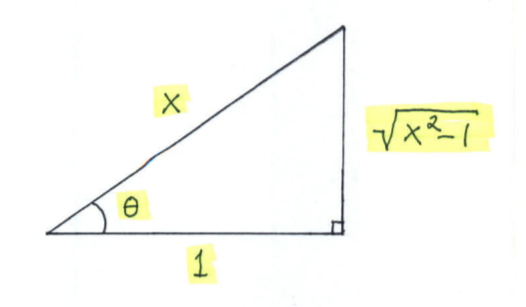SOLUTION 2: $ \ \ $ To integrate $ \displaystyle{ \int { (x^2-1)^{3/2} \over x } \, dx } $ use the trig substitution
$$ x = \sec \theta $$
so that
$$ dx = \sec \theta \tan \theta \ d \theta $$
Substitute into the original problem, replacing all forms of x, getting
$$ \displaystyle { \int \frac{(x^{2}-1)^{3/2}}{x} \ dx = \int
\frac{(\sec^{2} \theta - 1)^{3/2}}{\sec \theta} \ \sec \theta \tan
\theta \ d \theta } $$
$$ = \displaystyle { \int \frac{(\tan^{2} \theta)^{3/2}}{\sec
\theta} \ \sec \theta \tan \theta \ d \theta } $$
$$ = \displaystyle { \int \frac{\tan^{3} \theta}{\sec \theta} \
\sec \theta \tan \theta \ d \theta } $$
$$ = \displaystyle { \int \tan^{4} \theta \ d \theta } $$
$$ = \displaystyle { \int \tan^{2} \theta \tan^{2} \theta \ d
\theta } $$
(Recall that $ \tan^2 \theta = \sec^2 \theta -1 $.)
$$ = \displaystyle { \int \tan^{2} \theta (\sec^{2} \theta -1) \ d
\theta } $$
$$ = \displaystyle { \int (\tan^{2} \theta \sec^{2} \theta - \tan^2 \theta) \ d \theta } $$
$$ = \displaystyle { \int (\tan^{2} \theta \sec^{2} \theta - (\sec^2 \theta - 1) ) \ d \theta } $$
$$ = \displaystyle { \int (\tan^{2} \theta \sec^{2} \theta - \sec^2 \theta + 1 ) \ d \theta } $$
$$ = \displaystyle { \int \tan^{2} \theta \sec^{2} \theta \ d \theta } - \tan \theta + \theta + C $$
(Now let $ u = \tan \theta \ \longrightarrow \ du = \sec^2 \theta d \theta . $)
$$ = \displaystyle { \int u^{2} \ du } - \tan \theta + \theta + C $$
$$ = \displaystyle { u^{3} \over 3 } - \tan \theta + \theta + C $$
$$ = \displaystyle { (\tan \theta)^{3} \over 3 } - \tan \theta + \theta + C $$
$\Big($ We need to write our final answer in terms of $x$.

Since $ x = \sec \theta $ it follows that $ \theta = arc\sec x $ and
$$ \sec \theta = \displaystyle{ x \over 1 } = \displaystyle{ hypotenuse \over adjacent } $$
and from the Pythagorean Theorem that
$$ \displaystyle (adjacent)^2 + (opposite)^2 = (hypotenuse)^2 \ \ \longrightarrow $$
$$ (1)^2 + (opposite)^2 = (x)^2 \ \ \longrightarrow \ \ \ opposite = \sqrt{x^2-1} \ \ \longrightarrow $$
$$ \tan \theta = \displaystyle{ opposite \over adjacent }= \displaystyle{ \sqrt{x^2-1} \over 1 } \Big) $$
$$ = \displaystyle { \frac{1}{3} \Big( \sqrt{x^2-1} \Big)^3 - \sqrt{x^2-1} + arc\sec x + C } $$
$$ = \displaystyle { \frac{1}{3} (x^2-1)^{3/2} - \sqrt{x^2-1} + arc\sec x + C } $$
Click HERE to return to the list of problems.

